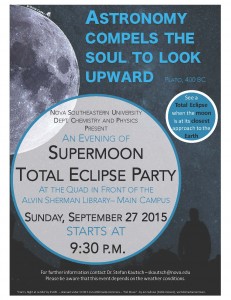NSU Newsroom
SharkBytes
Horizons
This version of NSU News has been archived as of February 28, 2019. To search through archived articles, visit nova.edu/search. To access the new version of NSU News, visit news.nova.edu.
This version of SharkBytes has been archived as of February 28, 2019. To search through archived articles, visit nova.edu/search. To access the new version of SharkBytes, visit sharkbytes.nova.edu.
Nova Southeastern University to Host Supermoon Total Eclipse Viewing Party
Public Invited to Witness a Rare Event – And Learn a Little About Astronomy
FOR IMMEDIATE RELEASE
FORT LAUDERDALE – DAVIE, Fla. – Look, up in the sky! It’s a bird! It’s plane! It’s a supermoon!
Okay, it may not be Superman, but still, it’s a supermoon, and that’s pretty cool. What makes the supermoon this September even more special is it will also be a total eclipse of the moon – something that’s pretty rare.
To mark the occasion, and to get people excited about science and astronomy, Nova Southeastern University (NSU) will be hosting a Supermoon Total Eclipse Party. The event, weather permitting, is scheduled for 9:30 – 11 p.m. (times are approximate) Sunday, September 27 in the quad in front of NSU’s Alvin Sherman Library, 3301 College Ave., Fort Lauderdale (NSU’s main campus.
Faculty from NSU’s Halmos College of Natural Sciences and Oceanography will be on hand to help interested observers peer through one of two large telescopes that will be on site, as well as provide information about the supermoon and total eclipse, in addition to other tidbits on astronomy. The event is free and open to the public, along with the NSU community. Participants can bring their own telescopes, image tubes and binoculars to join the fun.
Supermoons themselves are not that rare; coupling it with a total eclipse, however, is cause for astronomical celebration. A supermoon / total eclipse is special because it happens on average every 20–30 years. It combines a supermoon with a total lunar eclipse event. It occurs when the moon is closest to the earth, which causes the supermoon, and then earth blocks the sunlight on the moon, thus causing a total eclipse.
###
About Nova Southeastern University (NSU):Located in beautiful Fort Lauderdale, Florida, Nova Southeastern University (NSU) is a dynamic research institution dedicated to providing high-quality educational programs at the undergraduate, graduate, and first-professional degree levels. A private, not-for-profit institution with more than 24,000 students, NSU has campuses in Fort Lauderdale, Fort Myers, Jacksonville, Miami, Miramar, Orlando, Palm Beach, and Tampa, Florida, as well as San Juan, Puerto Rico, while maintaining a presence online globally. For more than 50 years, NSU has been awarding degrees in a wide range of fields, while fostering groundbreaking research and an impactful commitment to community. Classified as a research university with “high research activity” by the Carnegie Foundation for the Advancement of Teaching, NSU is 1 of only 37 universities nationwide to also be awarded Carnegie’s Community Engagement Classification, and is also the largest private, not-for-profit institution in the United States that meets the U.S. Department of Education’s criteria as a Hispanic-serving Institution. Please visit www.nova.edu for more information.
About NSU’s Halmos College of Natural Sciences and Oceanography: The college provides high-quality undergraduate and graduate (master’s and doctoral degrees and certificates) education programs in a broad range of disciplines, including marine sciences, mathematics, biophysics, and chemistry. Researchers carry out innovative basic and applied marine research programs in coral reef biology, ecology, and geology; fish biology, ecology, and conservation; shark and billfish ecology; fisheries science; deep-sea organismal biology and ecology; invertebrate and vertebrate genomics, genetics, molecular ecology, and evolution; microbiology; biodiversity; observation and modeling of large-scale ocean circulation, coastal dynamics, and ocean atmosphere coupling; benthic habitat mapping; biodiversity; histology; and calcification. The college’s newest building is the state-of-the-art Guy Harvey Oceanographic Center, an 86,000-square-foot structure filled with laboratories; offices; seminar rooms; an auditorium; and indoor and outdoor running sea water facilities. Please visit cnso.nova.edu for more information.
September 15, 2015
Joe Donzelli | Office of Public Affairs
954-262-2159 (office) |954-661-4571 (cell)
jdonzelli@nova.edu | www.nova.edu
